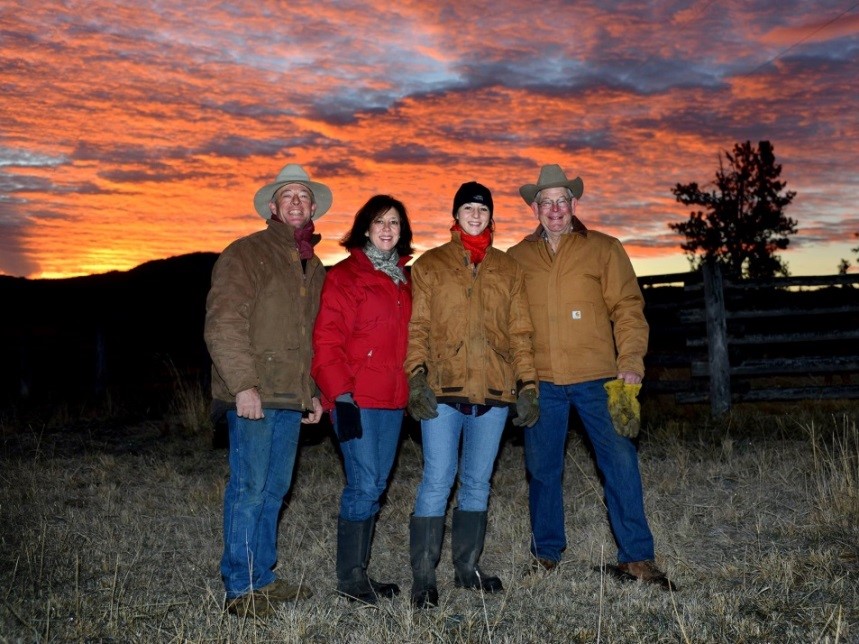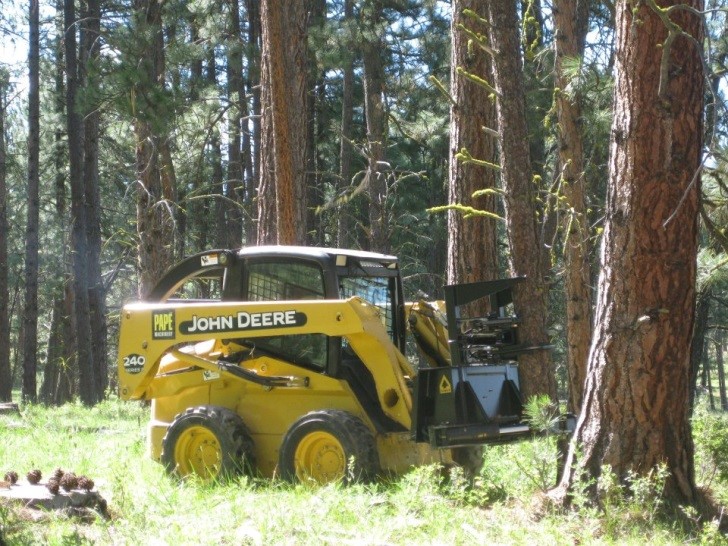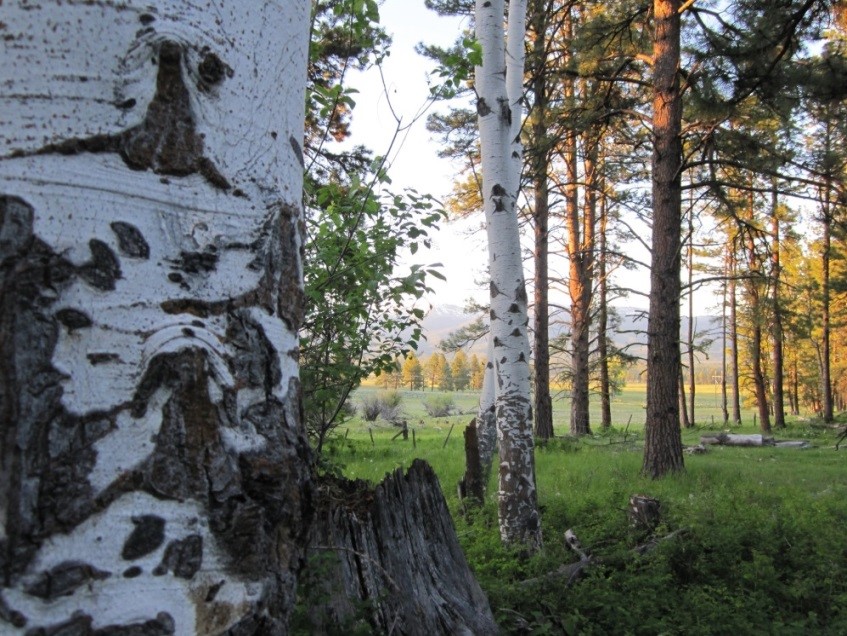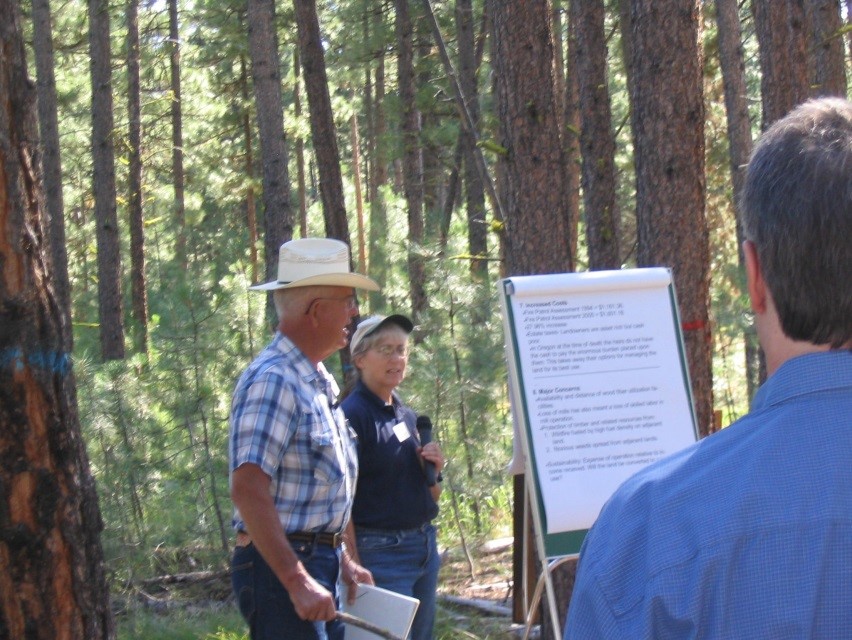Lyle and Dean Defrees from Oregon

What makes them outstanding?
The Defrees Ranch is a landmark in Baker County and Lyle Defrees is known for his knowledge, leadership, and generosity in his community. The Ranch is sustainably managed for all the values found in the American Tree Farm System plus all the social benefits found with people are interested in the best interests of their friends, neighbors and community. The family volunteers their time to help others and participates in volunteer organizations that benefit family forest owners, the ranching community, plus they serve on local and state governmental committees. They are well known and respected in their community and set an example for others to follow. With three generations of participation in management activities, the Defrees Ranch is poised to continue its role in the community.On the Defrees Ranch there is a balance of the benefits from both forestry and ranching. The results are great attention to wood, water, recreation, and wildlife and all the other attributes found on a working ranch in Northeast Oregon. All are done in a manner admired by those who know about their operations. The ranch is often used as an example of how to do things right. The family is willing to share their ideas with others and is known as leaders in their community and surrounding area. This leadership has been going on for generations and there are plans in place for it to continue for generations into the future.
Tree Farmer Story
 For 107 years the Defrees family has sustainably managed the Defrees Ranch. Lyle Defrees, son Dean, and granddaughter Dallas plan to continue that tradition on into the future. Even before the American Tree Farm System (ATFS) was created, the Defrees Ranch utilized the same guiding principles found in ATFS. The Defrees Family joined ATFS in February 1980 and has done an exemplary job of promoting the ideal and objectives of the American Tree Farm System by daily "walking the walk", demonstrating the highest commitment to environmental stewardship, forest management and livestock production. Lyle Defrees went through Oregon State Universityís Master Woodland Manager program and is often sought out by friends and neighbors for ideas and suggestions for managing their properties. The Defrees Ranch participated in the 2015 Oregon PEFC third party audit. Auditors were quire complementary on what they saw on the ranch. Lyle and Dean are very active in the local Oregon Small Woodlands Association (OSWA) chapter, holding leadership positions (including President) and partnering with Oregon State University Extension to plan, advertise and conduct numerous monthly information meetings, workshops and tours.
For 107 years the Defrees family has sustainably managed the Defrees Ranch. Lyle Defrees, son Dean, and granddaughter Dallas plan to continue that tradition on into the future. Even before the American Tree Farm System (ATFS) was created, the Defrees Ranch utilized the same guiding principles found in ATFS. The Defrees Family joined ATFS in February 1980 and has done an exemplary job of promoting the ideal and objectives of the American Tree Farm System by daily "walking the walk", demonstrating the highest commitment to environmental stewardship, forest management and livestock production. Lyle Defrees went through Oregon State Universityís Master Woodland Manager program and is often sought out by friends and neighbors for ideas and suggestions for managing their properties. The Defrees Ranch participated in the 2015 Oregon PEFC third party audit. Auditors were quire complementary on what they saw on the ranch. Lyle and Dean are very active in the local Oregon Small Woodlands Association (OSWA) chapter, holding leadership positions (including President) and partnering with Oregon State University Extension to plan, advertise and conduct numerous monthly information meetings, workshops and tours.
Lyle and Dean have also been instrumental in helping the Baker County Private Woodlands Association to envision and create the new Blue Mountain Forest Cooperative, an Oregon State recognized cooperative that is creating substantial economic value for woodland owners through a new aggregated sawlog sales program.The Defrees are constantly educating themselves to increase their scientific and practical knowledge about tree farming and livestock production in order to continually improve their management practices. And they work hard to use their wealth of knowledge to help educate their neighbors, friends and community about natural resource management through individual discussions, workshops, tours, and by participating in the creation of educational materials. Students from the Baker City School District visit the ranch on field trips.
Association to envision and create the new Blue Mountain Forest Cooperative, an Oregon State recognized cooperative that is creating substantial economic value for woodland owners through a new aggregated sawlog sales program.The Defrees are constantly educating themselves to increase their scientific and practical knowledge about tree farming and livestock production in order to continually improve their management practices. And they work hard to use their wealth of knowledge to help educate their neighbors, friends and community about natural resource management through individual discussions, workshops, tours, and by participating in the creation of educational materials. Students from the Baker City School District visit the ranch on field trips.
Oregon State University Extension uses the ranch for educational programs related to forest management, portable sawmilling, ranching and environmental protections.The Defrees family can always be counted on to advocate for small woodland owners and ranchers before the Oregon Legislature and regulatory agencies, providing powerful and persuasive testimony. A few years ago, Lyle participated in the extensive effort by the Oregon Department of Revenue to overhaul timber tax system, which included many trips to the Oregonís Capital, Salem, for exhaustive meetings to find a fair tax system. Dean was a leading member of the Baker County committee that collaborated with the Oregon Department of Forestry Fire Protection to update the county fire patrol assessment. This process took over two years and many long meetings to complete. Lyle also traveled to the Capital and testified in favor of the Wild Fire Protection Act legislation in 2013 that was passed and signed into law. The law became effective just in time for Oregonís extremely bad 2014 fire season. The additional funding for fire protection provided by the Wildfire Protection Act was credited with keeping the 2014 fire season from not being considerably worse than it was. It was also credited as a major help in the equally bad 2015 fire season.
Lyle has a well-deserved reputation as a meticulous and thorough record keeper, which is reflected in the outstanding management plan for the tree farm. Lyle has given presentations to the small woodlands group on writing management plans and has twice taught classes on record keeping at the Tree School East conference. And all the information he tracks isn't just ink on paper. Lyle does an excellent job of methodically detailing and analyzing data on their management activities to gain insights into the real costs and benefits of their work - information which he generously and eagerly shares with other woodland owners.Dean is active in the Oregon Cattlemanís Association and is part of a Natural Beef program providing high quality beef into the market place. This duel role as forester and rancher puts him in an ideal spot to understand the complexities of both forestry and ranching and to find common ground on issues that affect each differently.

Wood
The family commercially harvests timber each year. The use the Individual Tree Selection Method (ITM) is the current harvest strategy consistent with the typical silvicultural prescriptions needed in eastern Oregon to maintain healthy productive forests overtime. As stands mature, seed tree or shelterwood methods will be assessed for inclusion in the strategy. All harvesting is typically conducted during the winter months when there is snow cover and frozen ground to minimize site impacts. Chainsaw felling and tractor skidding operations have been replaced with a John Deere skid steer machine that also piles brush, improving efficiency and safety. The winter months are also a time when other ranch work slows down, allowing time to work on forest management. In the past 5 years over 100 acres have been ITM harvested producing approximately 100 MBF (thousand board feet) of sawlogs and over 2,000 tons of other wood products. The Defrees do their own harvesting and utilize a "one-pass" process where stocking control in the pre-commercial sized trees is conducted along with the Individual Tree Selection Method of commercial harvesting. All harvest work is followed up immediately with brush disposal, typically piling brush with the skid steer machine and burning slash in the fall and winter.To maintain the maximum growth potential, the forest stands are continuously being improved through stocking control, removal of undesirable trees, retaining preferred trees, and promoting conifer species diversity as appropriate for the stand and site conditions that are available. Release from brush competition has not been needed and fertilization is not economically viable on these sites. All reforestation on the property is accomplished through natural seeding from residual trees, except for the areas where aspen seedlings have been planted.
Water
In Eastern Oregon water can be a major concern particularly during the dry months of summer. Having adequate water for cattle, wildlife, fire protection, and domestic use is extremely important. There are no fish bearing streams on the Defrees Ranch. Property has two continuous flowing streams, three intermittent streams in summer months, one pond, six developed springs that run 0.5 to 13 gallons per minute with 583 gallon troughs for wildlife and livestock, eight undeveloped springs, one developed spring in the forest with water piped 3/4 mile to a 2,000 gallon cistern for domestic use, and one spring developed with a 1,200 gallon trough for forest fire fighting, wildlife, and livestock. Advancing water on the property is always a priority. Planned in 2016 are the development from a spring another 1,200 gallon trough for forest fire fighting, wildlife, and livestock and the development on another spring of four 800 gallon troughs for winter watering of livestock. The proactive placement placed of 1200 gallon water tanks throughout the property make sure livestock and wildlife have adequate water and to also serve as a source of water should a forest fire get started. Being able to respond quickly to a small fire can greatly reduce the probability of a large fire getting started on the property. Lightning caused fires are common during the summer months and a supply of water can make a big difference in putting such a fire out before it grows in size. There are several wet areas with aquatic plants such as cattails and quaking aspen. There are also elk and bear wallows used for bathing.
Wildlife
There is an abundance of wildlife on the Defrees Ranch. Their management strategy is to maintain and improve wildlife habitat. Game animals found on the ranch include Rocky Mountain elk, white tail deer, mule deer, antelope and turkeys. Habitat has been improved by leaving snags for cavity nesting mammals and birds, leaving adequate hiding cover for deer and elk and also leaving larger down wood. All these forest conditions benefit a variety of wildlife species. There are wet areas on the ranch that support aquatic plants such as cattails and quaking aspen. These attributes can benefit wildlife and are protected in the ranchís management. The family contracted with the Plant Works nursery in Cove, OR to grow aspen seedlings from tree farm stock and the seedlings were planted as part of the aspen restoration projects on the ranch. The Defrees ranch works in conjunction with neighbors, like the US Forest Service, in maintaining the natural conditions that benefit wildlife. The ranchís attention to water resources provides a big advantage to wildlife. The property is used by many water loving mammals and birds that call the ranch their home.
Recreation
Recreation on the Defrees Ranch takes many forms. It provides more than 250 man days of recreation per year, mostly in the form of hunting, but also for other types of recreation, for 45 to 65 members of the general public. This has been a policy for over 25 years. The ranch is a popular place to hunt for Rocky Mountain elk, white tail deer, mule deer, antelope and turkeys. The many educational visitors to the ranch consider the visit more like a recreational experience than an educational experience. There is no monetary charge to the guest and no time limit, but time must be scheduled. A party of one person or more that knows one another are allowed to use the ranch for recreation by written permission called a Courtesy Card which they carry. Permission to recreate is on a first-come, first-serve basis. People often express how much they appreciate the solitude and hunters quite often get a bonus by bagging a nice buck deer or bull elk. In some hunts the ranch is divided into two or 3 units to meet the ranch hunt objectives as opposed to a party using the entire acreage. On average, less than five acres of forest land provides one man day of recreation per year. Each year the ranch will host people from out of state such as Washington, Idaho, California, Utah, or Wyoming. The value of this program to the ranch is the opportunity we have to talk with the public about natural resource issues.Forest aesthetics are paramount on the Defrees Ranch. With the ITM harvesting system a mature forest is maintained. The management used on the ranch maintains the beauty of a working healthy forest that blends in with the natural environment in the area.


